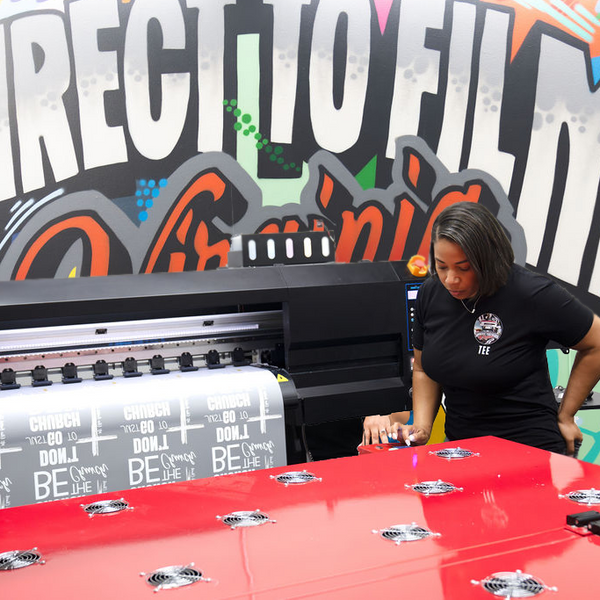One of the most common questions when designing a custom t-shirt is whether to choose Direct-to-Film printing DTF or screen printing. These methods might seem similar at a glance, but they have distinct characteristics that set them apart.
If you are looking to create a high-quality custom t-shirt, it's essential to understand the differences between DTF and screen printing. Are you ready to learn more? Let's take a closer look!
What is DTF printing?Direct-to-Film printing, also known as DTF, is a digital print method. The design you want to print on your t-shirt is first transferred onto transfer paper before being heated and pressed into the fabric.
It allows for extremely precise designs and high color accuracy, making it perfect for creating complex artwork that needs replication in detail. To get high-quality DTF printed custom apparel, visit DTF Virginia.
The entire process is automated, which helps speed up production and minimize labor costs. It makes it great for small-scale customizations or projects with a tight budget.
What is Screen Printing?Screen printing is also known as serigraphy. It is a traditional method that involves burning an image onto a screen. Ink is then pushed through this mesh to produce the end product. It's perfect for producing large runs of t-shirts, as it can be done quickly and efficiently at scale. Plus, there are many different screen printing techniques that you can look onto.
This method also allows for more creative freedom, as it can print on different types of material like paper or fabric. It is perfect for large designs or when you need to produce a larger number of the same shirt.
The Difference between DTF and Screen PrintingLet's compare the two methods to determine which is best for your project.
CostDTF is usually more cost-effective because it needs less labor and fewer materials. Screen printing requires a certain amount of preparation and manual labor. It is more expensive on a per-unit basis. If you are looking to create a large number of shirts, however, screen printing is the way to go.
QualityDTF prints have higher quality and more vibrancy than screen-printed designs. The colors are brighter and sharper and much more accessible to replicate across multiple garments. For this reason, it's ideal for complex artwork that needs to stay true to the original design. Screen prints can sometimes suffer from a lack of vibrancy or accuracy in the colors, making them less suitable for detailed designs.
DurabilityWhat do you think? Which method is more durable? Screen prints are more durable as they are printed directly onto the fabric, whereas DTF prints require heat transfer. It can add an extra layer between the design and the fabric, so it's essential to consider if you need a t-shirt that will last for a long time. However, to know how long they last, you have to consider a few factors.
VersatilityYou can use both methods on various materials, but DTF is better suited for more complex projects. It allows for finer details and higher design accuracy, making it perfect for intricate artwork. Screen printing is limited by size and labor costs, so it's best for large-scale designs that must be reproduced quickly and efficiently.
Fabric Compatibility
DTF can be used on various fabric types, including cotton, polyester, and blends. It's versatile and can adhere to different textures and colors. On the other hand, screen printing is limited to certain fabric types and colors. It works best on light-colored fabrics with a smooth texture. For this reason, it's best for projects with relatively simple designs.
Process of ProductionDTF printing is much faster since a button can transfer the design to the fabric. Screen printing requires manpower and manual labor, so it's slower in comparison. If you need your project done quickly, then DTF might be your better option.
Wash and WearBoth methods are durable and designed to withstand the test of time, but DTF prints can sometimes fade over a longer period. Screen printing requires no extra maintenance and will stay true to its original colors even after multiple washes. Screen printing is the way to go if you need a durable and long-lasting print.
Suitable Projects For Each MethodFor businesses like t-shirt brands, DTF is perfect for creating custom designs with intricate details. It's also great for small orders, as it requires little setup and can be done quickly and efficiently.
Screen printing is the go-to choice when you need to produce many identical shirts. This method can save time and money in the long run, as the labor costs are lower. It's also great for creating large designs that can't be done with DTF.
A project like a small run of t-shirts or bags can benefit from both methods. DTF works well for intricate designs with lots of detail, while screen printing is outstanding for large prints and multiple colors. It's essential to evaluate your needs and determine which method suits the job before beginning any kind of project.
What is better, DTF or screen print?- Final VerdictKeep in mind DTF and screen printing have strengths and weaknesses, so there is no one-size-fits-all answer. What works best for one project might not be the ideal choice for another. Take the time to weigh the pros and cons of each method against your project requirements.
If you are unsure about which method to choose, don't hesitate to contact professionals in the printing industry. They can provide valuable insights based on their expertise and help you make an informed decision.
Whether you opt for the precision of DTF or the efficiency of screen printing, your custom t-shirt project will rock with both.




























